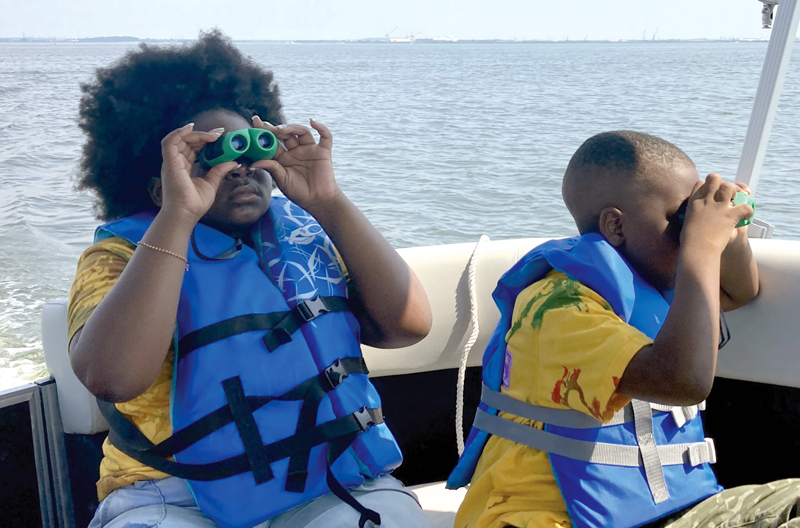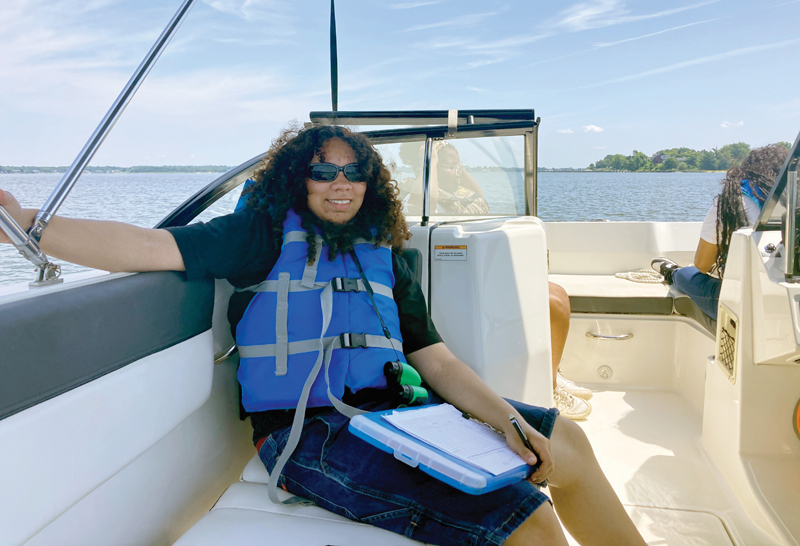This summer, Baltimore students collaborated with The Osprey Project 2025 and were empowered as student citizen scientists to share the osprey story and the importance of protecting all the creatures that depend on a healthy Chesapeake Bay.

Farewell, osprey friends; will they return?
October is one of the best times of year to be out on the Chesapeake or one of its meandering rivers: cruising, paddling, racing, wandering, daydreaming, and reflecting. These warm Indian Summer days and cool-to-chilly nights set the mood for sailing to a cozy cove, dropping the hook, and watching the harvest moon rise.
As I daydream about this overnight, I’ve got this refrain stuck in my head, “Bye, bye, so long, farewell… bye, bye, so long.” The story told in the 1966 hit song, “See You in September” by The Happenings, tells the story of young sweethearts parting ways at the end of the school year, wondering if their puppy love will survive summer vacation. Will they reunite when school starts in September? (Remember, back then, school always resumed after Labor Day!).
In my rewrite of the song, I’ve got different lovers in mind, and my seasons are reversed. For example, I’m wondering whether the osprey lovebirds we’ve been tracking all summer return to the South River Green 15 nest—in March not September—from their winter vacations in South America.
And, I’m enjoying the memories of working with Baltimore students who collaborated with The Osprey Project 2025 program.
Organized by my pal, Minister Brian Bordley, who runs One More One Less Mentoring, of Baltimore, the students help chart osprey nests in Baltimore’s Middle River, Bear Creek, and Stoney Creek, and in the Severn and South Rivers surrounding Annapolis. The students joined a groundbreaking program to create a long-term database of osprey populations.
This is outdoor field work! In a boat! They’re:
- getting their first on-the-water experience,
- participating in a valid scientific study,
- soaking up Vitamin D,
- enjoying the great outdoors, which is a salve for anxieties in a concrete world,
- getting a taste for the mariner’s life,
- and considering the various career opportunities that science, marine biology, and the environment offer.
Student mariners study osprey lifestyles
Armed with binoculars and data charts, with Minister Brian at the helm and yours truly serving as habitat instructor, we shove off and start charting osprey nests. Our student charges are now mariners and citizen scientists.
Easing away from the dock, we review the life cycle of osprey family-making: ospreys mate for life, return to the same nest every year to start a new generation, and are very territorial in defending their nests from solo osprey looking for their own mate.
They also learn how to tell mama from pappa osprey. Do you know how?
(Females have a ‘necklace’ of brown feathers around on their chest. Males have a solid white chest).
One of our students, rising junior Natalia, loves science. She quickly volunteered to help record the data (GPS coordinates for each nest, what type of structure the nests are built upon, number of osprey in each nest, vacancy rates of nests, male/female, chicks). And, by joining in the process, Natalia experienced a key building block of the scientific process—systematically recording data points.
“Why is recording data so important?” her habitat instructor asks.
“Because once you write it down, it becomes science!”
Excellent handwriting by the way. Thanks Natalia, this makes processing the data this fall so much easier.

Key to survival: teamwork
Our young scientists also learned what it takes for mama and papa osprey to successfully raise a family, and it’s all about teamwork. Papa osprey usually returns first in March and starts fixing up the nest.
Then, mama returns. If she sees papa doing a good job, she’ll rejoin him to rebuild the nest. Their mating dances in the sky signal the start of a new generation. By late May, mama starts laying the first of three eggs.
At this juncture, mama is stuck in her nest. She’s nest-bound because a host of predators (crows, eagles, snakes, hawks, owls, raccoons, and even other osprey) are always lurking about. It only takes a couple of seconds for a crow to swoop in to steal an egg. Eagles, owls, and hawks can easily carry away an unguarded chick.
It’s papa’s job to stand guard in a tree nearby to sound an intruder alarm. It’s also his job to feed the growing family. This is no simple task. He’s under constant pressure to hunt for more and more fish for mama and the chicks. The more chicks that are born, the more fish he has to bring home. Papa does occasionally take over the guardian role in the nest to give mama a break and hunt for herself, but these are short-lived reprieves.
It’s no wonder that by the time the chicks grow to become fledglings and can fly in mid-July, an exhausted mama osprey says, “My time is done. You’re on your own now, kids.” Off she goes, flying down to South America where she will winter until February when instincts tell her it’s time to return to her nest in the Chesapeake. Same with papa. He leaves once the young can feed themselves.
During a lunch break on Bear Creek outside of Baltimore, when reviewing what’s been learned on our three-hour cruise, a rising junior shared how the osprey lives reflect human families, that momma seems to do all the work in the nest (home), and that it takes team work and dedication to raise a family.
After the students paused to consider her remarks, another student, who lives in inner Baltimore miles from the water, admitted he’d never heard of osprey before. He was echoing a theme all the students shared. You don’t see osprey on the streets of Baltimore.
At their age, I had never seen an osprey along the banks of the Potomac River, where they once thrived. They had disappeared from US waterways due to DDT poisoning after World War II. DDT was used to kill mosquitos, but it also caused osprey and eagle eggshells to become so thin that their chicks could not survive to hatch. Populations crashed. It wasn’t until DDT was banned in 1972 that these birds slowly, very slowly, rebuilt their populations. In 2025, the devastation caused by DDT is over. Now, the osprey face new challenges caused by pollution, climate change, and resource management.
This summer’s experience empowers our student scientists to share the osprey story and the importance of protecting all the creatures that depend on a healthy Chesapeake Bay.
by Tom Guay
About the Author: Thomas Guay plays music with the Eastport Oyster Boys, shares tunes and tales about Annapolis’s golden era on the Schooner Woodwind, and is the author of the new historical novel, “Chesapeake Bound” (McBooks Press). Learn more at thomasguay.com.




